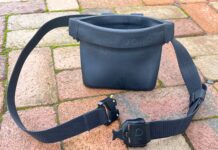So, Im flying this week with a small dog, a carry-on dog, in the cabin. Im transporting my daughter-in-laws dog from her previous home in Boston to her new home here in California. When she moved here, she flew with an 18-month-old, extremely active boy, and that seemed like enough with which to burden a young mother flying otherwise alone. Her dog has been languishing for a few months with her parents, waiting for someone in the family to fly with, in the passenger cabin. I dont recommend flying a dog as cargo except when there is absolutely no other choice, and only under specific conditions.
Why? Everything I know about flying dogs appears in the May issue.
Unfortunately, one of the things I learned when researching this issue is that there is no such thing as airline-approved carriers for small dogs. Or rather, I learned that the phrase does not, in reality, mean what all of us think it means. The popular understanding of the phrase is If I buy this airline-approved carrier, I will be able to carry my small dog on the plane (with proper reservations/booking, of course).
In reality, airline-approved tends to mean, Some airline allowed someone sometime to carry a dog in this bag on board, but dont count on this happening when YOU check in for a flight with YOUR dog on any given day.
The airline agent manning the front counter for your flight are the ones who decide whether or not your carrier is approved for that flight. And the persons approval not only varies by individual, by the airline she or he works for, but also by the specific model of airplane (or airplanes, if you have a multi-leg flight) used in your itinerary.
This is primarily because there is a great deal of variation in the size of the bag that can fit under the seat of various airplanes.
But airline agents are also the ones who will look at your bag to make sure that it is in good condition and can securely contain your dog (if it looks too flimsy, torn, or the zippers dont close tightly, they can reject it, and your dog, from that flight). They also are empowered to (and charged with) making certain that your dog is in a carrier of an appropriate size that you havent stuffed a too-large dog into a too-small bag. Your dog is supposed to be able to stand, turn around, and lie down comfortably in the bag. Puppies who are younger than 8 weeks are not supposed to be carried (or shipped) on airplanes, either, and ostensibly, the front counter personnel can ask for verification that the puppy is of sufficient legal age to travel.
Some agents have great judgment and experience at this job, and some do not. Some may allow a too-young puppy or too-large dog stuffed into a hot, uncomfortable crate onboard, and some may stop a perfectly appropriately crated dog in a perfectly good and appropriate carrier from flying.
The article that appears in the May issue discusses how you can stack the deck in your favor, to make as certain as you can that you and your dog will be appropriately prepared for acceptance onto the flight.
But Im curious: How many of you have flown on commercial flights carrying your small dog? Have you ever been prevented from carrying your dog on board? If so, why? And how did you solve the problem? And if youve never had a problem with the front counter agents, tell us your secret!





